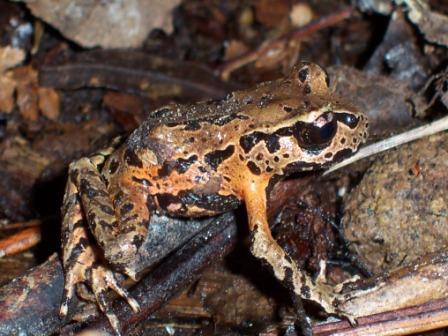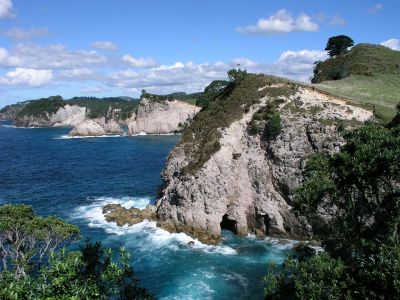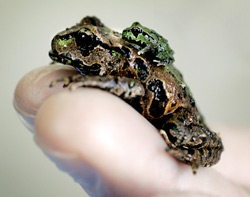Archey’s Frog: Part of a Clean Green New Zealand?
 If Charles Darwin was alive, he’d be the first to campaign against the recent Government land mining proposals in New Zealand that will threaten the world’s most evolutionarily distinct amphibian, Archey’s Frog. But New Zealand wouldn’t do that, it’s ‘clean, green’. It cares for its endemic species. It can’t be true, can it?
If Charles Darwin was alive, he’d be the first to campaign against the recent Government land mining proposals in New Zealand that will threaten the world’s most evolutionarily distinct amphibian, Archey’s Frog. But New Zealand wouldn’t do that, it’s ‘clean, green’. It cares for its endemic species. It can’t be true, can it?
Money from Minerals
What’s a tiny frog (and a little bit of native forest) worth when compared to the money the country could make from mining minerals? Just think how how the country would grow economically, just think of the increase in exports. Just think how it could keep up with Australia. Just think how RICH the country could be. Possibly $140 million richer says the Government. (But maybe $85 million says the New Zealand Institute of Economic Research or $14 million according to the World Bank) Okay, so we can deduce that no one knows how much this protected land is worth in terms of mineral wealth. We do, however, have a pretty good idea how much it is worth ecologically.
Archey’s Frog – Tiny but Significant
The main home of Archey’s Frog, this evolutionarily distinct and globally endangered amphibian, is in the Coromandel, north New Zealand. The exact spot where mining is being considered. For 40 years conservation groups have been monitoring the frog populations in this area with Archey’s Frog taking on special significance, not only because it is endangered, but because biologically it is indistinguishable from the fossilised remains of frogs that lived 150 million years ago, leading to its description as a ‘living fossil’. It’s one very special frog. Currently it is threatened by a particular fungal disease as well as rats and mice. If the Government’s mining plans go ahead, those will be the least of its worries. It will become homeless, and without adequate habitat the species will die out. And no, they can’t be kept in conservation zoos either, many attempts by Auckland Zoo have been made to breed this little creature but to no success.
Archey’s Frog is one of the world’s most primitive frogs. It has ‘tail-wagging’ muscles but no tail. It has no eardrums so is thought to use scent to communicate. The male of the species is the father-figure, looking after the eggs in the nest until the frogs hatch and then carrying them on his back for several weeks. They don’t have a tadpole stage. They are born as an almost fully-formed frog. The adult frog is 37 mm in length.
The World is Watching
It’s not just a national issue anymore. The world is waiting to hear the outcome of the Government’s proposals. The Zoological Society of London (ZSL) recently spoke out against the mining proposals: ‘In the year when reducing biodiversity loss is high on the political agenda, it is inconceivable to think that we’d put the nail in the coffin of some of our rarest and most extraordinary frog species,’ says Helen Meredith, projects coordinator of ZSL’s EDGE (species on the edge of existence). Auckland Zoo equally does not support the removal of conservation land for mining potential. As well as the devastating loss of Archey’s Frog, they say, the removal of the forest would destroy habitat for wildlife including brown teal, kaka, kiwi (species the zoo breeds for release to the wild) and Hochstetter’s frog.
It Started Off Well
It’s not as if effort hasn’t been made to protect the biodiversity of NZ. The former Labour Government amended the Crown Minerals Act to include ‘Schedule 4’ to protect national parks, wilderness areas, marine reserves and ecological areas of interest by precluding all mining activities and most exploration activities. It is this Schedule 4 that is under scrutiny by the current National party. They are considering ‘unprotecting’ some of the Schedule 4 land. As Auckland Zoo conservation officer Peter Fraser says ‘to renege on such a commitment to our wildlife and wild places is unthinkable and totally counter-productive to New Zealand’s long-term prosperity.’
 Political Proposal
Political Proposal
You’ve probably got a fair idea on where I stand with the issue, but to balance out the argument, here is what the National party said in March 2010 when they announced the mining proposals. They are looking at 7000 ha of land currently under Schedule 4 protection. 7000 ha is only 0.2% of the Schedule 4 protected land with the Government suggesting ‘if that land subsequently saw mining development, only around five per cent of the land might actually be mined – as little as 500 hectares.’ And they also aimed ‘to add a further 12,400 hectares – a net gain in protected areas of 5,342 hectares.’
So?
Not as bad as it first sounds? Maybe, maybe not. But even though we’re only talking about 0.2%, that’s the 0.2% of land where Archey’s Frog lives and has lived for 150 million years. You have to make a decision, DO YOU WANT MINERAL WEALTH OR ECOLOGICAL WEALTH? In a small country such as New Zealand it seems ridiculous to compete with the wealthy nations, it’s never going to be a rich country, there are not enough people. But what we can focus on is the maintenance of a biodiverse and ecologically rich land. Isn’t that worth more than $140 million dollars?
Make a submission to the Government by clicking here. It’s quick and easy. Closing date is 26 May at 5 pm.
This article is also posted on Animal blog.
loading...
loading...
Tags: Biodiversity, Endangered Species, Environment, News, Politics




What’s the way forward here? I’m keen to know your thoughts. I’m thinking now’s the perfect time for NZ to launch the grand dream of becoming the must sustainable nation in the world. Yes yes big broad dreaming, but think of the opportunities! NZ leading the way with sustainable travel, power generation and usage, parenting, farming … think of the market advantage! Oh the premiums. I know it’s important to focus on what we want and what we’re excited about. And this is a rather important issue. As I said, I’m keen to know what your thoughts are? How do we navigate through this and keep our national parks intact?
loading...
loading...